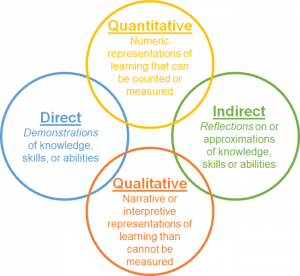Gathering Evidence
At the heart of assessment is the systematic collection and examination of evidence of student learning.
Types of Evidence
There are two sets of overlapping categories that all assessment evidence fall into:
- Quantitative or Qualitative
- Direct or Indirect
The Venn diagram below illustrates how these categories interact with one another. Effective assessment should triangulate a variety of kinds of evidence in drawing conclusions about student learning. The more congruent the evidence that is gathered from various approaches, the greater confidence you can have in the results.
Sources of Evidence
Levels of Evidence
It is also essential to understand what the appropriate threshold is to make decisions about the curriculum. Exactly how much evidence is enough? You should aim to gather enough evidence to be confident in making decisions based on that evidence. Another way to describe that threshold could be that assessment evidence should be clear and convincing. That phrase may sound familiar from the legal world, which has distinct ways of describing different levels of evidence.


